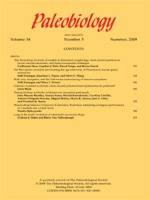The process of evolution hinders our ability to make large-scale ecological comparisons—such as those encompassing marine biotas spanning the Phanerozoic—because the compared entities are taxonomically and morphologically dissimilar. One solution is to focus instead on life habits, which are repeatedly discovered by taxa because of convergence. Such an approach is applied to a comparison of the ecological diversity of Paleozoic (Cambrian–Devonian) and modern marine biotas from deep-subtidal, soft-substrate habitats. Ecological diversity (richness and disparity) is operationalized by using a standardized ecospace framework that can be applied equally to extant and extinct organisms and is logically independent of taxonomy. Because individual states in the framework are chosen a priori and not customized for particular taxa, the framework fulfills the requirements of a universal theoretical ecospace. Unique ecological life habits can be recognized as each discrete, n-dimensional combination of character states in the framework. Although the basic unit of analysis remains the organism, the framework can be applied to other entities—species, clades, or multispecies assemblages—for the study of comparative paleoecology and ecology. Because the framework is quantifiable, it is amenable to analytical techniques used for morphological disparity. Using these methods, I demonstrate that the composite Paleozoic biota is approximately as rich in life habits as the sampled modern biota, but that the life habits in the modern biota are significantly more disparate than those in the Paleozoic; these results are robust to taphonomic standardization. Despite broadly similar distributions of life habits revealed by multivariate ordination, the modern biota is composed of life habits that are significantly enriched, among others, in mobility, infaunality, carnivory, and exploitation of other organisms (or structures) for occupation of microhabitats.
How to translate text using browser tools
1 March 2007
Using a theoretical ecospace to quantify the ecological diversity of Paleozoic and modern marine biotas
Philip M. Novack-Gottshall
ACCESS THE FULL ARTICLE

Paleobiology
Vol. 33 • No. 2
March 2007
Vol. 33 • No. 2
March 2007




